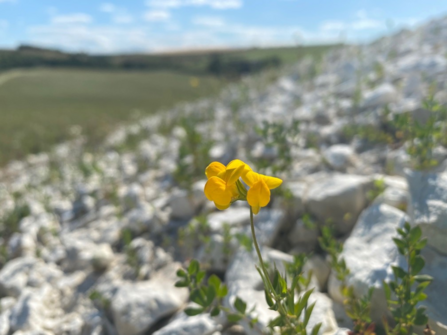Southern Reserves Manager, Ashley White, reflects on the conservation works that have been carried out at Coombe Bissett Down over the past three years of the project.
Coombe Bissett Project Update (Part Two): Conservation Works & Land Management
What are the main objectives?
Restore 17 hectares of arable land to species-rich chalk grassland
The restoration process will enable us to buffer the SSSI downland and create significant ecological connectivity between the reserve and other species-rich downland in the local area, increasing this priority habitat and benefitting the threatened species it supports.
Arable reversion
Wildflowers are easily outcompeted by other plants if soil fertility is high. For the first two years of the project spring barley was grown in this field without added fertiliser, until samples indicated that the soil nutrients had been sufficiently reduced. A final crop was harvested in early autumn 2019, and the field was cultivated several times before it was sown that October with wildflower seed that had previously been collected from areas of species-rich grassland elsewhere on the nature reserve.
The newly sown field was visited in June, July and August 2020. The visits were encouraging, with target wildflowers yellow rattle (an annual grass hemiparasite sown to keep grass growth in check), viper’s-bugloss (a biennial), ox-eye daisy, hoary plantain, black knapweed, sainfoin, bird’s-foot trefoil, and wild carrot (all perennials) observed in flower. While the sward remained relatively open, with plenty of bare ground, additional seed was purchased for oversowing, which was carried out in autumn 2020.
During the first few years seeds of volunteer crops and other non–target species can be expected to germinate. These are usually short lived annual or biennial plants that can be prevented from going to seed through a combination of cutting and sheep grazing, and will gradually reduce over time.
Monitoring of the establishing flora will continue over successive springs and summers. If this interests you and you would like to assist with survey and monitoring as a volunteer please get in touch with CBDProject@wiltshirewildlife.org
New features to support and encourage wildlife
These have included:
- The enhancement of the Beeches Hill field through plug planting of Devil’s bit scabious for target butterfly species marsh fritillary.
- The construction of a large chalk butterfly bank (see previous blogs Building a butterfly bank and Scattering and nattering at Coombe Bissett Down ), planted and sown with the food plants of target butterflies: small blue, Adonis blue, and dingy skipper.
- Planting new species-rich hedgerows to improve connectivity between existing hedges, and providing a source of food and shelter for invertebrates, birds and small mammals.
- Provision of winter food to support farmland birds
- Installation of nest boxes on farm buildings for house sparrow, common swift, barn owl and kestrel.

Improve the sustainability of the farm and conservation management of Coombe Bissett Down nature reserve
Farm infrastructure has been constructed to support the conservation grazing. Items included new stock fencing and field gates to secure reserve boundaries, water supply and troughs, and livestock housing to allow greater flexibility of grazing.
Habitat management tools have been purchased. The bridleway from the A354 has been upgraded, providing an access point for staff and volunteers to transport tools and materials to the centre of the reserve. If you are interested in conservation volunteering at Coombe Bissett Down or livestock checking at some of our other reserves in southern and mid Wiltshire please visit our Volunteering page.

